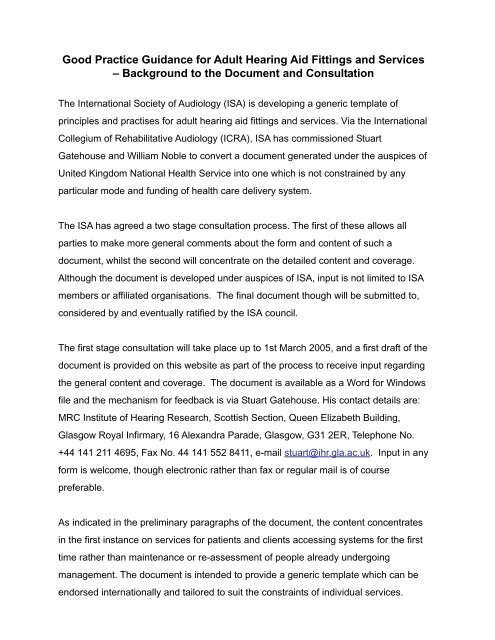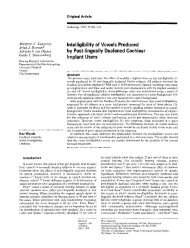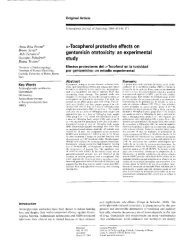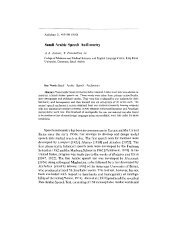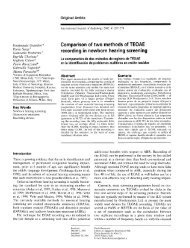Good Practice Guidance for Adult Hearing Aid Fittings and Services ...
Good Practice Guidance for Adult Hearing Aid Fittings and Services ...
Good Practice Guidance for Adult Hearing Aid Fittings and Services ...
You also want an ePaper? Increase the reach of your titles
YUMPU automatically turns print PDFs into web optimized ePapers that Google loves.
<strong>Good</strong> <strong>Practice</strong> <strong>Guidance</strong> <strong>for</strong> <strong>Adult</strong> <strong>Hearing</strong> <strong>Aid</strong> <strong>Fittings</strong> <strong>and</strong> <strong>Services</strong><br />
– Background to the Document <strong>and</strong> Consultation<br />
The International Society of Audiology (ISA) is developing a generic template of<br />
principles <strong>and</strong> practises <strong>for</strong> adult hearing aid fittings <strong>and</strong> services. Via the International<br />
Collegium of Rehabilitative Audiology (ICRA), ISA has commissioned Stuart<br />
Gatehouse <strong>and</strong> William Noble to convert a document generated under the auspices of<br />
United Kingdom National Health Service into one which is not constrained by any<br />
particular mode <strong>and</strong> funding of health care delivery system.<br />
The ISA has agreed a two stage consultation process. The first of these allows all<br />
parties to make more general comments about the <strong>for</strong>m <strong>and</strong> content of such a<br />
document, whilst the second will concentrate on the detailed content <strong>and</strong> coverage.<br />
Although the document is developed under auspices of ISA, input is not limited to ISA<br />
members or affiliated organisations. The final document though will be submitted to,<br />
considered by <strong>and</strong> eventually ratified by the ISA council.<br />
The first stage consultation will take place up to 1st March 2005, <strong>and</strong> a first draft of the<br />
document is provided on this website as part of the process to receive input regarding<br />
the general content <strong>and</strong> coverage. The document is available as a Word <strong>for</strong> Windows<br />
file <strong>and</strong> the mechanism <strong>for</strong> feedback is via Stuart Gatehouse. His contact details are:<br />
MRC Institute of <strong>Hearing</strong> Research, Scottish Section, Queen Elizabeth Building,<br />
Glasgow Royal Infirmary, 16 Alex<strong>and</strong>ra Parade, Glasgow, G31 2ER, Telephone No.<br />
+44 141 211 4695, Fax No. 44 141 552 8411, e-mail stuart@ihr.gla.ac.uk. Input in any<br />
<strong>for</strong>m is welcome, though electronic rather than fax or regular mail is of course<br />
preferable.<br />
As indicated in the preliminary paragraphs of the document, the content concentrates<br />
in the first instance on services <strong>for</strong> patients <strong>and</strong> clients accessing systems <strong>for</strong> the first<br />
time rather than maintenance or re-assessment of people already undergoing<br />
management. The document is intended to provide a generic template which can be<br />
endorsed internationally <strong>and</strong> tailored to suit the constraints of individual services.
The document attempts to establish good practice from a published evidence base <strong>and</strong><br />
international consensus regarding good practice, making the assumption that good practice<br />
should not be constrained in the first instance by the availability of resources.<br />
It is hoped that a wide range of parties <strong>and</strong> perspectives can feed into the two-stage<br />
consultation process, with the second phase running from 1 st April 2005 till 1 June 2005.<br />
The documents to be submitted to the International Society of Audiology <strong>and</strong> considered by<br />
the ISA Executive Board in July 2005.<br />
Any difficulties in downloading the document either at this website or elsewhere (the<br />
documents are to be lodged at www.ISA-audiology.org, www.icra.nu, www.ihr.gla.ac.uk <strong>and</strong><br />
www.une.edu.au/psychology/staff/noble.htm.) should be addressed to Stuart Gatehouse<br />
using the above contact details.<br />
SEE DOCUMENT ON FOLLOWING PAGES
GOOD PRACTICE GUIDANCE FOR<br />
ADULT HEARING AID FITTINGS AND SERVICES<br />
Prepared <strong>for</strong> the International Society of Audiology, November 2004, by the<br />
<strong>Good</strong> <strong>Practice</strong> Working Group of the International Collegium of Rehabilitative<br />
Audiology<br />
1. Background<br />
1.1.This document contains a set of statements <strong>and</strong> recommendations <strong>for</strong> good practice<br />
in hearing aid fittings <strong>and</strong> services. It attempts to distil the results of current<br />
evidence <strong>and</strong> consensus practice into a series of statements which can be used to<br />
frame service provision. It addresses technical aspects of hearing aid fittings <strong>and</strong><br />
rehabilitative support, but does not address in any detail the resource requirements<br />
(e.g. accommodation, staff <strong>and</strong> hardware) <strong>for</strong> service delivery.<br />
1.2.The guidance is framed in the context of adults with mild, moderate <strong>and</strong> severe<br />
hearing impairment who are accessing a service <strong>for</strong> the first time. Profound<br />
impairments may require separate processes. In addition the guidance does not<br />
cover specialist services such as cochlear implants or bone anchored hearing aids.<br />
For existing hearing aid fittings procedures will differ, though probably will contain a<br />
sub-set of the recommendations.<br />
1.3.The document is written as though the whole process is delivered by a single<br />
integrated service. Where different professionals or agencies are responsible <strong>for</strong><br />
different elements, local documents should acknowledge the local structure <strong>and</strong><br />
h<strong>and</strong>-over between agencies. Systems should be in place to ensure that all<br />
elements are included, <strong>and</strong> that in<strong>for</strong>mation flow <strong>and</strong> cross-referral occurs in a<br />
seamless manner.<br />
1.4.The guidance concentrates on good practice. Where local circumstances place<br />
constraints (e.g. in cash-limited State or insurance schemes or individual income in<br />
the private market), the guidance should be amended accordingly. Similarly, where<br />
in a private-pay environment individual financial resources limit access, there should<br />
be explicit local variations on the guidance.<br />
1.5.The document makes the assumption that management of hearing impairments,<br />
disabilities <strong>and</strong> h<strong>and</strong>icaps (activity limitation <strong>and</strong> participation restriction in ICIDH-2)<br />
is a comprehensive process involving rehabilitative support, provision of personal<br />
amplification <strong>and</strong> assistive listening device options. It is not a simple technical<br />
matter of hearing aid provision alone.<br />
1.6.The guidance concentrates on the signal processing <strong>and</strong> fitting features associated<br />
with hearing aid management. It makes no assumptions regarding the mode of<br />
technological implementation (e.g. analogue or digital).
2. Infrastructure<br />
2.1.All facilities, test rooms <strong>and</strong> equipment <strong>for</strong> the assessment, fitting <strong>and</strong> evaluation of<br />
hearing <strong>and</strong> hearing aids should con<strong>for</strong>m to the appropriate international <strong>and</strong><br />
national st<strong>and</strong>ards <strong>and</strong> recommendations.<br />
2.2.All materials <strong>and</strong> methods used in assessment <strong>and</strong> management should con<strong>for</strong>m to<br />
the appropriate recommended procedures.<br />
2.3.All procedures should be undertaken by staff with appropriate professional<br />
qualifications <strong>and</strong> training All staff should have an agreed structure <strong>and</strong> process <strong>for</strong><br />
Continued Professional Development.<br />
2.4.All equipment used <strong>for</strong> testing <strong>and</strong> evaluation should be calibrated to the appropriate<br />
national <strong>and</strong> international st<strong>and</strong>ards on at least an annual basis.<br />
2.5.Service providers should have in place appropriate referral routes <strong>and</strong> in<strong>for</strong>mation<br />
flow between the various agencies <strong>and</strong> professions responsible <strong>for</strong> service delivery.<br />
3. Assessment<br />
3.1.Necessary assessment of auditory impairment will take place prior to any decision<br />
that appropriate management includes the provision of personal amplification. This<br />
decision will require at least pure-tone air <strong>and</strong> bone conduction thresholds, though<br />
further assessment of impaired auditory function may be appropriate prior to any<br />
decisions concerning the details of hearing aid management <strong>and</strong> rehabilitation.<br />
3.2.The decision-making process regarding appropriate hearing aid management (as<br />
opposed, <strong>for</strong> example, to surgical or medical management) will be dependent upon<br />
local service <strong>and</strong> professional arrangements, but should be explicitly stated in local<br />
protocols <strong>and</strong> policies.<br />
4. Integration <strong>and</strong> Goal setting<br />
4.1.As an initial first stage of any intervention, a comprehensive assessment of needs<br />
should be conducted to <strong>for</strong>mulate an Individual Management Plan. A <strong>for</strong>mal selfreport<br />
instrument with recognised properties such as the Client-Orientated Scale of<br />
Improvement (COSI) or the Glasgow <strong>Hearing</strong> <strong>Aid</strong> Benefit Profile (GHABP) should be<br />
used. The above are illustrative only <strong>and</strong> the choice of instrument is <strong>for</strong> each<br />
individual service provider, though it should be an explicit element of policy <strong>and</strong><br />
employed throughout. The same instrument may be re-administered to assess<br />
outcome at subsequent follow-up.
4.2.The Individual Management Plan should address all issues including hearing aid<br />
fitting, rehabilitative support, <strong>and</strong> environmental modification (e.g. assistive<br />
listening devices). There will be hearing-impaired patients <strong>for</strong> whom a hearing aid<br />
is not an appropriate element of the Individual Management Plan.<br />
4.3.The Individual Management Plan should contain input from family members <strong>and</strong><br />
significant others as appropriate. This involvement is particularly important in<br />
devising management plans <strong>for</strong> patients who do not appear to acknowledge<br />
hearing difficulties.<br />
4.4.All aspects of the Individual Management Plan should be in<strong>for</strong>med by both the<br />
needs <strong>and</strong> goals of the hearing-impaired person, <strong>and</strong> the in<strong>for</strong>med advice of the<br />
professional responsible <strong>for</strong> configuring <strong>and</strong> delivering the intervention.<br />
5. Fitting<br />
5.1.The minimum technical characteristics of an individual hearing aid fitting should<br />
consist of a linear hearing aid with low-distortion output compression limiting.<br />
Profound losses might require different policies. Note that this minimum st<strong>and</strong>ard<br />
does not imply a norm or default, but a true service baseline. Each fitting of the<br />
minimum st<strong>and</strong>ard should con<strong>for</strong>m to a recognised rationale (e.g. NAL-RP) with<br />
established validity <strong>and</strong> per<strong>for</strong>mance in the scientific <strong>and</strong> clinical literature. The<br />
choice of rationale is <strong>for</strong> each individual service provider, though it should be an<br />
explicit element of policy <strong>and</strong> applied throughout.<br />
5.2.Current research evidence suggests that at least 75% of patients will gain clinically<br />
relevant additional benefit from hearing aid fittings with features over <strong>and</strong> above<br />
the minimum st<strong>and</strong>ard. Examples of such features include amplitude<br />
compression, directional microphones <strong>and</strong> feedback suppression. These additional<br />
features should be available to all patients as required. The fitting of devices<br />
above the minimum st<strong>and</strong>ard should con<strong>for</strong>m to a recognised generic (eg NAL-<br />
NL1 or DSL [i-o]<br />
) or product-specific rationale <strong>and</strong> be documented as part of the<br />
clinical record.<br />
5.3.Where a fitting rationale contains an acoustical target, each hearing aid fitting<br />
should be verified by real ear measurement using an input stimulus appropriate <strong>for</strong><br />
the hearing aid under test prior to any fine-tuning. Tolerances to the prescription<br />
rationale of ± 5dB at frequencies of 250 Hz, 500 Hz, 1000 Hz <strong>and</strong> 2000 Hz <strong>and</strong> of<br />
± 8dB at 3000 <strong>and</strong> 4000 Hz should be achieved in all cases. In addition the slope<br />
in each octave should be within ± 5dB/octave of the target. Where it is not<br />
desirable or possible to achieve a prescriptive target (e.g. because of feedback<br />
issues) or where the measurement is not technically feasible, the clinical record<br />
should contain an explicit statement to this effect. Note that some losses can only<br />
be fitted to the appropriate target using the flexibility that accompanies digital<br />
implementation. Note also that some fitting rationales do not contain an acoustical<br />
target : in such cases this step is not required.
5.4.The maximum power output of each hearing aid fitting should be adjusted according<br />
to a recognised prescription rationale (e.g. based on prediction from hearing<br />
thresholds as in NAL-SSPL <strong>and</strong>/or loudness judgements <strong>for</strong> appropriate stimuli).<br />
This choice should be an explicit element of local policy.<br />
5.5.At the fitting session, the hearing aid frequency response <strong>and</strong> maximum power<br />
output (<strong>and</strong> other characteristics where appropriate) should be adjusted to achieve<br />
patient acceptability according to an explicitly laid-down local protocol. Fine-tuning<br />
<strong>for</strong> optimal (as opposed to an acceptable) fit is more appropriate at a subsequent<br />
follow-up visit following appropriate listening experience.<br />
5.6.The service should offer to patients the choice of post-aural (behind-the-ear, BTE)<br />
<strong>and</strong> in-the-ear (ITE/ITC) fittings where these are compatible with the patient’s needs<br />
<strong>and</strong> capabilities. The process leading to a decision of BTE or ITE/ITC should be an<br />
explicit element of the clinical record. A small number of patients will be best served<br />
by body-worn devices.<br />
5.7.The default <strong>for</strong> all hearing aid provision should be to offer bilateral fittings. Unilateral<br />
fittings should only be offered where a) one ear is not sufficiently impaired to merit<br />
amplification, b) one ear is so impaired that amplification would not be beneficial, or<br />
c) a specific audiological or other rationale. There will be a material proportion of<br />
patients <strong>for</strong> whom bilateral provision is not appropriate <strong>for</strong> audiological <strong>and</strong> other<br />
(e.g. manipulative ability, otological or age-related) reasons. Where unilateral<br />
provision is offered, this <strong>and</strong> the reasoning should be an explicit element of the<br />
clinical record.<br />
5.8.Where the patient declines a bilateral fitting, bilateral provision should be re-offered<br />
at a later stage of the rehabilitative process once the patient has experienced the<br />
benefits of unilateral amplification. Because of the perceptions raised by current<br />
policy of only offering bilateral fittings to severely <strong>and</strong> profoundly hearing impaired<br />
patients, a material proportion of users will decline bilateral fittings (“I’m not that deaf<br />
doctor”), but will accept <strong>and</strong> benefit from bilateral fittings following unilateral<br />
experience.<br />
5.9.<strong>Hearing</strong> aid provision should include appropriate in<strong>for</strong>mation about hearing, listening<br />
skills, hearing aid technology <strong>and</strong> earmoulds. There should exist local protocols <strong>for</strong><br />
the assessment of <strong>and</strong> instruction in manipulation skills with regard to hearing aids<br />
<strong>and</strong> earmoulds both at the hearing aid fitting session <strong>and</strong> at follow-up.<br />
5.10. Following the fine-tuning <strong>and</strong> other adjustments the acoustical properties of each<br />
hearing aid fitting used by patients in everyday listening should be documented<br />
using real ear measures, irrespective of whether the rationale used <strong>for</strong> fitting<br />
contains an acoustical target. The stimuli used <strong>for</strong> real ear measures should be<br />
appropriate <strong>for</strong> the signal processing in the hearing aid. This in<strong>for</strong>mation is required<br />
<strong>for</strong> subsequent interpretation of listener’s comments about subsequent experience<br />
with the fitting at the follow-up visits.
5.11. All patients should have access to a facility to remediate listening problems by<br />
additional consultations prior to a <strong>for</strong>mal follow-up visit.<br />
6. Follow-up<br />
6.1.The management of hearing-impaired patients will include sessions covering<br />
assessment, fitting <strong>and</strong> at least one follow-up session. The timing, time-allocation<br />
<strong>and</strong> content of each session should be explicit elements of local policy <strong>and</strong> should<br />
be sufficient <strong>for</strong> the application of each element of good practice. Aspects of these<br />
elements may depend on the hearing aid features available in any fitting <strong>and</strong><br />
requirements <strong>for</strong> rehabilitative support.<br />
6.2.All patients should have a review visit between three <strong>and</strong> six weeks after hearing aid<br />
fitting. At this review visit, a measure of outcome in the self-report disability <strong>and</strong><br />
h<strong>and</strong>icap domains should be administered to assess benefit <strong>and</strong> guide ongoing<br />
management. This process may be deferred to a subsequent review visit if<br />
immediate remedial action is required to ensure acceptability of the fitting. This<br />
assessment will be directly linked to the needs assessment outlined above <strong>and</strong><br />
often may employ the same measurement instrument. Alternatively an additional<br />
measure aimed solely at outcome assessment such as the Abbreviated Profile of<br />
<strong>Hearing</strong> <strong>Aid</strong> Benefit (APHAB) or the International Outcomes Inventory <strong>for</strong> <strong>Hearing</strong><br />
<strong>Aid</strong>s (IOI-HA) may be used. The data from the needs assessment <strong>and</strong> the outcome<br />
measure allow intra-departmental assessment of the effectiveness <strong>and</strong> cost<br />
effectiveness of local protocols <strong>and</strong> services as a whole <strong>and</strong> <strong>for</strong> patient sub-groups.<br />
6.3.Fine-tuning at follow-up after real-world aided listening experience is an essential<br />
second stage of any provision strategy <strong>and</strong> should include <strong>for</strong>mal assessment of a<br />
range of listening circumstances relevant to the individual patient. This will include<br />
ratings (either absolute or paired-comparisons) of intelligibility <strong>and</strong> listening com<strong>for</strong>t<br />
<strong>for</strong> everyday signals (often speech) at a variety of levels in quiet <strong>and</strong> in noise. There<br />
should be an explicit local policy <strong>for</strong> fine-tuning. Following any fine-tuning or the<br />
activation of additional processing or fitting features a real ear measure should be<br />
used to document the acoustical properties of each hearing aid fitting.<br />
6.4.On the basis of either the initial Individual Management Plan, or the assessment of<br />
benefit <strong>and</strong> residual disability at follow-up (eg shortcomings in initial provision),<br />
hearing aid fittings with the appropriate features (e.g. single or multi-channel<br />
amplitude compression, directional microphone, feedback management, multiprogramme<br />
etc.) should be available to all patients. <strong>Hearing</strong> aid provision should<br />
match technological features to listeners’ disabilities <strong>and</strong> lifestyle.<br />
6.5.The methods <strong>and</strong> criteria <strong>for</strong> the matching of hearing aid technology, earmould<br />
characteristics, rehabilitative support <strong>and</strong> environmental modification (eg assistive<br />
listening devices) to the Individual Management Plan should be laid down in a local<br />
protocol. The detailed decisions should be an explicit component of the clinical<br />
record.
6.6.Further fine-tuning of fittings <strong>and</strong> changes in provision should take place at<br />
subsequent follow-up visits as required. Each of the follow-up visits should detail<br />
the actions taken <strong>and</strong> the success or otherwise of those actions by repeat<br />
administration of the outcome measure of choice.<br />
6.7.Rehabilitative counselling <strong>and</strong> support services should be available to meet the<br />
needs of each Individual Management Plan, <strong>and</strong> to ensure optimum benefit from<br />
hearing aid fittings. All hearing impaired patients should be counselled with regard<br />
to hearing tactics <strong>and</strong> listening skills. The necessary staff skills <strong>and</strong> resources<br />
should be available in each service setting.<br />
6.8.<strong>Services</strong> <strong>for</strong> environmental modification (e.g. assistive listening devices) should be<br />
available as needed <strong>for</strong> all listeners even when these services are administered by<br />
other agencies. Each audiology service provider should establish effective liaison<br />
with relevant external agencies to meet the needs of each Individual Management<br />
Plan. Integration of these responsibilities <strong>and</strong> funding streams into a<br />
comprehensive care system should be achieved whenever possible.<br />
7. Ongoing Support<br />
7.1.Patients should only exit the cycle of follow-up visits when all available steps have<br />
been taken to satisfy the needs assessment or when they decline further support.<br />
All patients should be reviewed at least every three years as part of a process of<br />
continuing care. There should be an “open access” system in place <strong>for</strong> review<br />
be<strong>for</strong>e the due date if required by hearing aid users.<br />
7.2.Ongoing support <strong>for</strong> hearing aid users should be provided via repair clinics <strong>for</strong><br />
routine service <strong>and</strong> “open access” clinics <strong>for</strong> emergency care.<br />
7.3.Each service should implement an in<strong>for</strong>mation management system which allows<br />
ready access to process, activity <strong>and</strong> outcome data to facilitate audit <strong>and</strong> clinical<br />
governance as an ongoing monitoring of clinical effectiveness <strong>and</strong> costeffectiveness<br />
of policy <strong>and</strong> protocols.<br />
7.4.This guidance refers repeatedly to local policies <strong>and</strong> protocols to implement good<br />
practice. Each service provider should prepare <strong>and</strong> publish a set of overall<br />
documentation, whose clinical effectiveness <strong>and</strong> cost effectiveness should be<br />
reviewed on an annual basis. Service providers may find it helpful to <strong>for</strong>m<br />
consortia <strong>for</strong> the development of policies <strong>and</strong> protocols. There should be an<br />
annual audit of process (e.g. waiting times <strong>for</strong> appointments) <strong>and</strong> outcome (using<br />
the outcome measure of choice laid down in local policy).<br />
ISA <strong>Good</strong> practice guidance.doc<br />
November 2004


